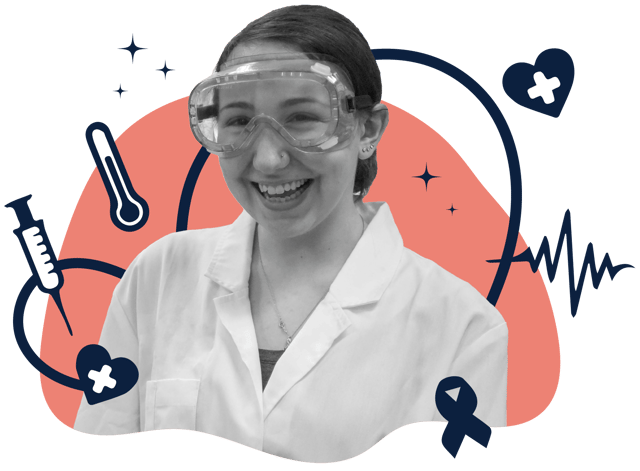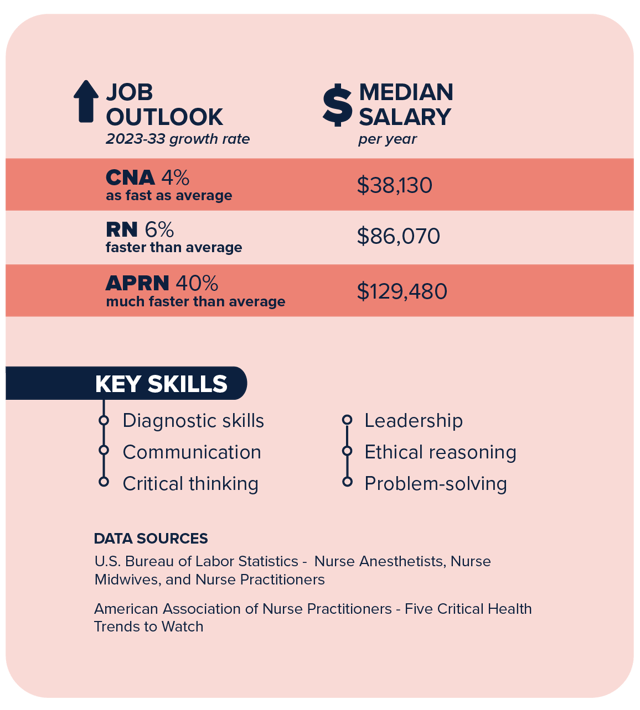
Each May, we celebrate the amazing work of nurses and the positive impact they have on our health and communities. Helping students discover their passion for nursing early on can propel and prepare the next generation to fill much-needed roles in healthcare and medicine. Scroll down for ways to learn about the topic in your classroom!

Meaningful Ways to Celebrate Nurses Week in the Classroom
It’s never too late—or too early—to inspire students to pursue a nursing career! Explore the integral role nurses play in your community and everyday lives with these in-school activities and hands-on learning opportunities. Visit the National Nurses Week website for more ideas and resources about nursing.
-
Use graphics and social posts from this toolkit from the National Association of School Nurses to recognize your school’s nurse! Give students an opportunity to ask about the career of nursing using prompts like these:
- What types of treatment have you received when you were hurt or sick?
- Have you ever gotten care from a school nurse? How did the nurse help you feel better?
- What skills does a school nurse need to have? Examples include problem-solving, critical thinking, ethical reasoning, communication, active listening, time management, empathy, and teamwork
-
Learn what it’s like to be a nurse in various areas by watching these videos. Give students a real-life connection by inviting the school nurse to come into the classroom and describe what their day is like.
- Elementary Students: Talk About It: Who Takes Care of Us? (Blog + Video)
- Middle School Students: What Does a Clinical Nurse Do? (Video)
- High School Students: Perspectives from an RN/BSN (Video)
-
Many nurses, especially those who specialize in orthopedics or emergency care, must learn how to apply casts for various injuries. Invite a nurse from the community to the school to demonstrate the critical thinking and problem-solving skills used when deciding which cast to apply to stabilize a broken bone. Use the prompts below to guide students through the learning experience.
Cast Yourself in the Role of a Nurse
How Do We Stabilize a Broken Bone?
Important Definitions
- Cast A hard covering that is put on an injured body part to keep it from moving.
- Diagnosis The act of identifying a disease, illness, or problem by examining its signs and symptoms.
- Treatment Medical care given to a patient for an illness or injury.
Components of an Effective Cast
- Strong to hold the bone in place and keep the wrist from moving.
- Light so that the patient can lift their arm.
- Comfortable so it doesn’t hurt or bother the patient.
- Water Resistant so that it’s not destroyed by a little bit of water.
Discussion Questions
- What is the function of a cast? A cast helps broken bones heal.
- How does the structure of a cast support its function? A cast should be strong to hold the bone(s) in place and prevent the bone(s) from moving. This helps the bone(s) heal. A cast should also be light and comfortable so the patient can wear it for a period a time.
- How might a cast for a broken leg differ from a cast for a broken wrist? A cast for a broken leg will be larger and shaped differently than a cast for a broken wrist.
- What type of cast might be useful to help the break shown below heal? For a greenstick fracture like the one shown below, a short arm cast would be applied. This type of cast is applied below the elbow to part of the hand.

Want to explore the structure and function of the human body in your elementary classroom? Bring more critical thinking, problem solving, and design thinking with curriculum from Project Lead The Way (PLTW). This learning experience was inspired by the “Design a Cast” problem from the PLTW Launch module, Structure and Function: Human Body. Learn more at pltw.org/pltw-launch.
-
Ask students to research the qualities, certifications, and education needed to become a Registered Nurse (RN). Using the Important Qualities listed by the Bureau of Labor Statistics (BLS), guide an open-ended discussion with your students. Suggested prompts include:
- Which of the Important Qualities listed for Registered Nurses do you already possess?
- What are some scenarios that might require nurses to apply some or all of the Important Qualities listed?
- How might these Important Qualities be useful in other professions, even outside of healthcare?

Bring reading and English language arts (ELA) into the mix by writing thank-you notes for nurses in your community. Use this printable template and encourage students to find and include an interesting nursing fact with their note.
STEM to RN: Student and Educator Spotlights
School districts that introduce students from an early age to the array of professions in biomedical science and healthcare provide more opportunities to uncover their interests. With curriculum that’s vertically aligned from PreK through 12th grade, even the youngest students learn about and build key skills for a variety of career paths in medicine. Watch the videos to hear from real science and healthcare professionals who discovered their passion in PLTW.

Careers in Nursing: A Growing Opportunity
Nurses provide and monitor patient care alongside healthcare teams in various settings. Certifications vary by education, from short CNA programs to advanced degrees like a Doctor of Nursing Practice. Students who build relevant knowledge and skills in high school unlock a career advantage that empowers the next generation of healthcare professionals.
Real Programs, Real Stories: From Classroom to Career
- Two nurses whose desire to have a career in nursing led them to discover unique and exciting applications of their knowledge and skills. Read the Story
- How two schools in Kentucky and Florida implement PLTW Biomedical Science curriculum differently—both with positive student outcomes. Explore the Outcomes
- How PLTW Biomedical Science students in Texas performed compared to non-PLTW peers who took similar classes. View the Data
- Why students and professionals in a South Carolina community value their school’s PLTW Biomedical Science program. See What They Said

Start Transforming Your Classrooms
-
Explore Our Curriculum
-
Plan for PLTW
-
Discover the Difference
-
Connect with a Team Member Today
